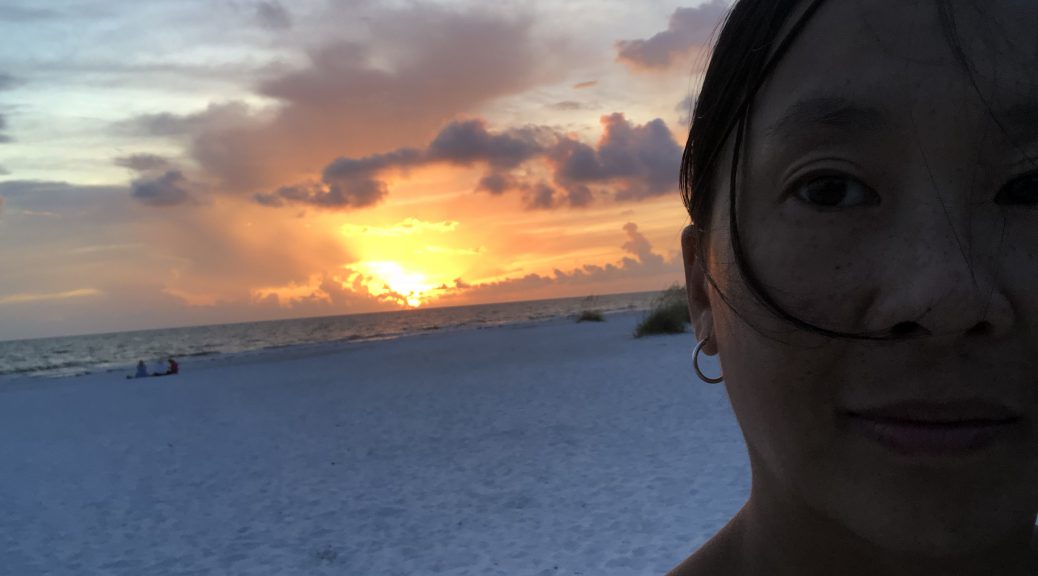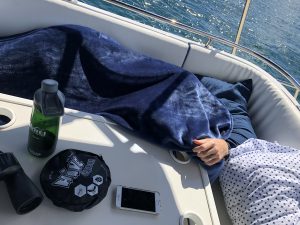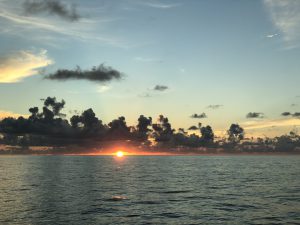
8-10 September 2018: Days of Wonder
We rested in Gulfport, rising late, getting a good breakfast in and doing what repairs and chores had cropped up. Today we would make the long run to Panama City, setting our course east and going straight on until morning.
The Gulf could not be more welcoming. We piloted for much of the daylight hours from the flying bridge. Above, the wind kept everyone refreshingly cool and dry. The canvas shade protected us from the warm sun, and the added height gave us good visibility. The fly bridge even had a comfortable settee ideal for napping.

Our navigation relied upon chart plotter and autopilot. Robert would program a route with waypoints at each turn. The chart plotter and autopilot would work together with the GPS to run for so long at such-and-such a heading and then turn to the next heading and run in that direction for another given amount of time. That helped the helm immensely by allowing him or her to concentrate on the surrounds. Often in the ICWW we would have to deviate from the planned route to go around obstacles, or more often, give way for other boats.
The route to Panama City was much different. Fewer waypoints with multiple hours between each point. After we left the busy channel that marked Gulfport, large commercial vessels gave way to smaller personal watercraft, many huddled in the meager shelter of one of the channel markers. Folks out on a fine Saturday morning to put their pole in the water and see what they could catch. After a while, even those boats disappeared.
In little time at all we were well and truly on our own. The limit of human vision on a flat surface, like the Gulf of Mexico, is about ten miles. Land receded. The busy ship traffic fell away. The skittery little fish boats dwindled to nothing. We went for hours without a target save what excitement the seas might provide us. Dolphin. Turtles. A sting ray. Fleshy-pink jelly fish floated by too numerous to count. Nautical mile after nautical mile of gracious sea breeze, warm tropical sun, and the sleepy roll of the ocean.

By nightfall, we had worked out our shift schedule. We would each take a four-hour turn at the helm, with one other to spot and keep company. It would mean that we’d all be short on sleep the next day, but that was what naps were for. Robert would take the shift from dusk to 2300. I would take 2300 to 0300, and Breck took the 0300 to sunrise shift. I would be Robert’s spotter, Breck would be mine, and Robert would spot Breck.
With the company, the shifts went surprisingly well. I had had the foresight to download some interesting podcasts before, so we had hours of radio entertainment to keep us all up. Ironically, the best podcast of the evening was an interview Neil DeGrasse Tyson had done with renowned oceanographers Sylvia Earl and Fabian Cousteau. Dr. Earl began in the newly emerging field in the 70s and had logged over 7000 hours of scuba diving. Cousteau, the grandson of the iconic Jacques Cousteau had the title aquanaut, which is given to individuals who log enough dive time that their bodies equilibrate to the higher pressure. For Mr. Cousteau, he had spent thirty-days submerged under pressure.
NDT and his guests talked about how the ocean is a living system. It is an integral part of how the planet regulates itself to provide a life-sustaining environment for… well, us. A couple of the statistics really struck me. For example, the oceans of the earth absorb 22 million tons of carbon dioxide every day, about a third of the daily production of carbon dioxide. The absorption of such astronomical (pardon the pun) amounts of carbon dioxide is not without consequence. Water and carbon dioxide mix to form an acid, and this ocean acidification leaches precious calcium carbonate from the water. Why is that important? Because many ocean organisms need calcium carbonate to form their sea shells. Things like clams, oysters, and coral. Some of those organisms, like plankton, albeit microscopic, support huge food chains. When the organisms for the food chain don’t grow, everyone up the food chain starves.
There was a witty banter in the podcast about what was more romantic, the allure of the ocean or the call of space. The oceanographers arguing that we come from the sea, and NDT arguing that we are made of stardust. In the end the comparison was strangely appropriate for the Adventuress crew.
We had decided that at the 0300 shift change, after we’d turned away from the brightly lit shores of Mobile Alabama, we’d slow our roll and do some stargazing. It turned out to be one of those bucket list moments.
The sky was clear now. Up until about 0100 hours, we had been running parallel to shore. All night we’d watch as thunderstorms raked the shore, clouds strobing with angry lightning. But since we were off-shore we had the rare opportunity to watch the lightshow from afar. We had turned away from shore at 0100, and now with the shore at our stern, the night truly closed in on us.
I’ve seen clear nights when the stars are out. Sometimes I can even pick out a constellation or two. This night, far from the orange sodium glare of civilization, ALL the stars were out. Millions and millions. I saw for the first time in my life the starry smear of the Milky Way. I saw all the stars that made up Orion, not just the three that make his belt. As we stood on the bow of our boat struck dumb with wonder, meteors started to fall. We watched for the silently streaking falling stars for what seemed like forever when a splash in the water startled us from our reverie.
The dolphins had come out to play.
We were idling, only going a few knots, and a band of playful dolphins rode our bow wave with cetacean abandon. In the dark, with only the light from the stars and our running lights to illuminate, it was hard to say how many there were, only that it seemed that for some distance we were surrounded by them. They jumped and rode the waves that Adventuress made, one playful individual even jumping up out of the water with some rotation so that he landed on his back. We heard the exhalations from their blowholes as they played, and their chattery clicks and squeaks as they called to one another.
As day broke, and we all came together in the morning after our night run, we decided to continue the run and make for Tampa. The weather had been very fine and was only predicted to get calmer. The run to Tampa would take us another full day and a half, but then we might be able to get to Fort Lauderdale before our airplane to Seattle left without us.
The second day pretty much followed the same routine as the first day. The most comfortable place to be was on the flying bridge, where the sunshade protected us from the heat, and the wind kept us cool. We took turns napping, piloting, and whatever else. Breck entertained us by playing his guitar (he’s very good). We saw flying fish startled into smooth flights many yards over the waves, more jelly fish, and more dolphins.
A MOMENT ON THE BRIDGE OF ADVENTURESS…
As we settled into the night shifts, it was clear that we were all struggling now. All of us were a little bit sticky, a little bit uncomfortable, and a little bit tired. As Breck put it, we were all happy when our shifts were done. This night started with us far from any sources of light pollution, so as soon as it got dark all the stars were out again. Saturn burned so brightly low on the western horizon that you could see its light reflected in the calming seas. The Milky Way was again visible, and we used Breck’s star app to identify Jupiter and Mars, which are not stars, of course, but this night they outshone the other stars in the sky.
This night had in store for us more spectacular sights, if you could imagine. As we made our way south and east towards Tampa, we passed thunderstorm after thunderstorm. We never got wet, but as our course picked its way between storm after storm, we were treated with another sort of light show. All night the skies lit up with lightning. We saw distinct bolts of white or yellow, orange, and on one occasion reddish. Sometimes the clouds just lit up, as if the god of thunder were arc-welding in there. Other times the whole sky flashed momentarily. Once, we watched a storm strobe lightning at an almost predictable two or three second interval for almost a minute.
Mind you, did I mention it was dark? It was dark. Having lived most of my life in the glow of human habitation, it beggars my imagination to describe how dark it was, but it was really dark. We navigated by radar, mostly. But, we had one incident on the second night was really an object lesson in safe navigation.
Breck, with sharp eyes and good night vision was the first to spot the light. It was directly ahead. We watched it as we progressed, but it didn’t show up on radar, and it never seemed to get closer. Then suddenly, a contact appeared within a nautical mile of us on the radar. I was on the helm, so I immediately throttled her back. I had Breck light us up with additional lighting on the flying bridge and wake Robert. I made a course correction to avoid what still only looked to my eyes to be a pinprick of light in the far distance, and we passed the radar contact by a little more than a half nautical mile. Still, robbed of any depth perception by the darkness it felt as we had missed catastrophe by the whiskers.
In the daylight, cruising through waters so calm you could see the reflection of clouds in them, we were mobbed by a group of eleven or so dolphins. We first saw them on our starboard, jumping and swimming a parallel track, but I will swear that as we approached them they veered course to intercept. That group—pod? What do you call a group of dolphins?—rode our wake for probably a mile, jumping and veering in and out of the waves port and astern. The water was so clear, you could count their freckles.
As I write now, we are but a few nautical miles outside of Tampa. This year, Florida has been beset by a plague of algal blooms. Sickly green and deadly poisonous, this year’s algal blooms have even made news in the PNW for its death toll. Fish by the beachful, manatee, dolphins, and even a whale. We have just cruised into it, and the brilliant azure is gone, replaced by something that looks a cross between pea soup and snot. The news warned that the algal blooms were so concentrated that even the smell had made people feel sick. I’m sitting on the fly bridge right now, and I am beginning to smell something distinctly fishy. I guess it’s time to go in.
Finally, on land after the longest run Robert and I have ever done. Fifty-two hours and 342 nautical miles. Tomorrow, Breck will leave us to return to civilization, and more holy crow! More habitable climes. Our gratitude and love to Breck, and to Ramona, his fantastic wife for tending the home fires and watching after our pup-pup. We’ll be home soon.